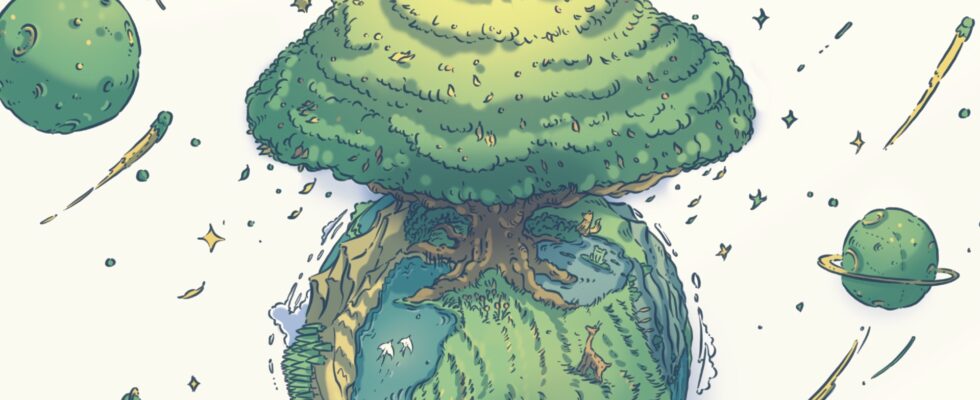This week, we present to you two board games around planting trees. Either in small pots, in Bonsaior to revegetate an entire planet, in Evergreen.
There are certain recurring themes in board games, which often work in waves. A few years ago for example, we were drowned in an endless stream of zombie games, then later Vikings games, etc.
For some time now, “nature” games have been a bit of a trend. Trees and flowers grow there. Animals, insects and birds are raised there. These are often games with limited interaction between players, where you can’t really do nasty things to others. And with generally accessible rules, to play with the family.
So much so that some people are a little fed up with games around this theme… but not us. On the contrary, we rather like it. And we take this opportunity to introduce you to two “nature” games discovered recently.
Do you like planting trees? You will be served!
Bonsaiplant zen
In Bonsai, you play experts in the ancestral art of bonsai (yes!) and seek to grow the most beautiful miniature tree. It’s not a win, since at the start of the game we only have a pot from which a small shoot timidly protrudes.
Each turn, you have the choice between two actions: meditate or cultivate.
Meditating consists of choosing a card among those proposed, which gives you knowledge on the art of cultivating a bonsai, tools to help you, and brings back small tiles (trunk, leaf, flower or fruit).
By farming, you add previously acquired tiles to your tree. More or less depending on your knowledge. But not just anyhow. A trunk must be adjacent to another trunk. A leaf adjacent to a trunk. A flower adjacent to a leaf. And an adjacent fruit with two leaves.

Your tree thus grows little by little, with branches forming, leaves and flowers growing, which perhaps give fruit.
This layout that you put in place depends on objective tiles. Depending on the objectives of the game, certain elements of the tree earn more or fewer points. Sometimes you have to favor trunks and flowers, other times leaves, etc. But be careful, when you complete an objective (a bonsai with 3 fruits for example), you must claim it immediately, making it unavailable to your opponents, or give it up to aim higher… at the risk of not succeeding.
At the end of the game, you also score points thanks to the leaves, flowers and fruits of our tree.
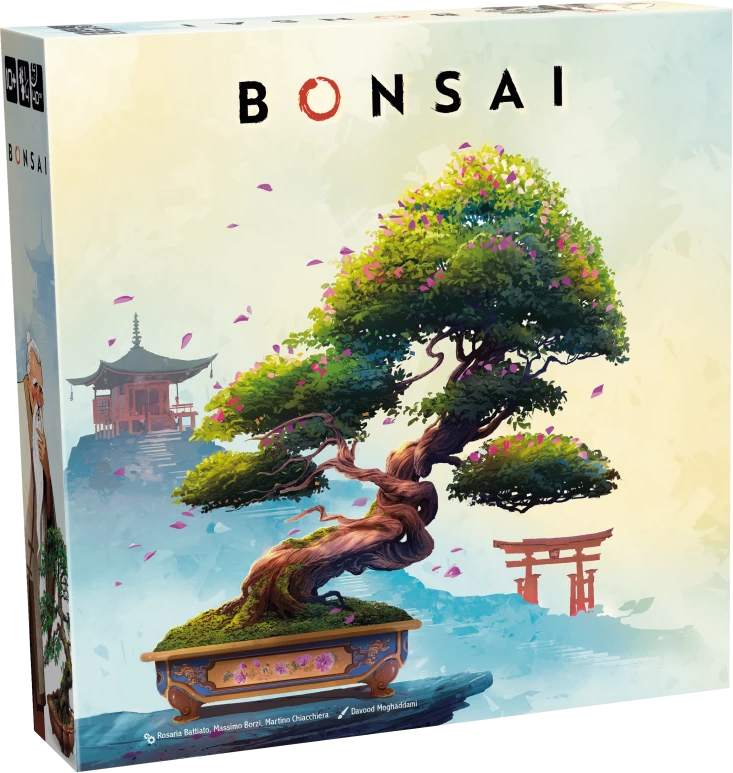

Bonsai is a game chill and zen par excellence. We really enjoy seeing our tree grow and making it bloom. Depending on the chance of the objectives and the draw, it will take a different shape, with more or fewer branches, large piles of leaves, lots of fruit, etc.
The rounds are fast, and so is the game. Too much even, the first times. The game is so relaxing that you take your time, and you don’t notice until it’s too late that the draw pile is already almost empty, synonymous with the end of the game.
The following times, we optimize better, we take more risks on the objectives, we arrange our tree better to score more points.
But in any case, we will have built something, we will have a beautiful bonsai in front of us. And we won’t be able to blame others if we lose, because interaction is almost absent from the game.
A great family game with a relaxing theme.
- Bonsai is a game by Rosaria Battiato, Massimo Borzì and Martino Chiacchiera
- Illustrated by Davood Moghaddami
- Published by Gigamic
- For 1 to 4 players from 10 years old
- For games of around 40 minutes
- Priced at €39.95 at Philibert
In short
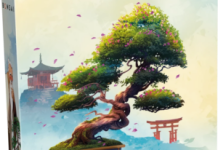

We liked
- We take pleasure in growing our bonsai (whether we win or lose)
- It’s beautiful !
- Simple rules, fast and smooth rounds
- The dilemma regarding objectives (should we try to do better?)
We liked it less
- The chance of the draw
- The games end a little quickly
Evergreenmake a place for yourself in the sun
Your goal in Evergreen is to make your planet as lush as possible. At the start of the game, it is completely empty, as if dead, without any fauna on its surface. Only made up of six different biomes (swamp, mountain, meadow, etc.), and dotted with small dug locations in which your plants will grow.
On your turn, you choose a card from those offered, then you play your action.
The card taken indicates in which biome of your planet you can carry out your action, from a choice of four. These allow different combinations for planting or growing a plant. We always start by planting a shoot, and later transform it into a shrub, then a tree.
Each card is also associated with a power, the effect of which is applied before or after its action of the turn, and which improves with each use.
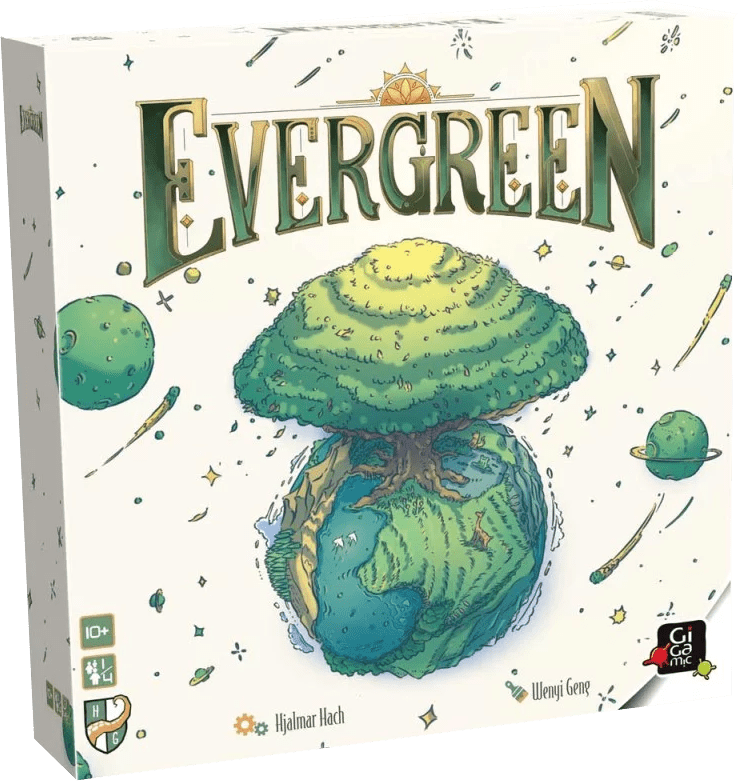

Obviously, we don’t plant and grow our trees just anywhere or anyhow. A card is set aside each turn, and indicates in which biomes our trees will earn points at the end of the game.
At the end of each round, your plants also benefit from the sunshine, and score points if they benefit from the sunlight… provided they are not in the shade. Indeed, a shrub projects its shadow on one square behind it, and a tree on two squares. But be careful, because each round, the sun turns a quarter of a turn, to shine in a different direction.


Even before playing, Evergreen is a real feast for the eyes. Whether it’s the illustrations of the cards, or the little pawns in the shape of a shrub, tree, etc., cute as anything. Maybe even a little too small to handle with big fingers.
What we like even more is its mechanics. Fluid, simple, but extremely intelligent. Each choice has serious consequences. The map we choose imposes the biome in which we will plant. The map we leave indicates the biomes that will earn points. The locations of our trees are important for enjoying the sun… but be careful the next time around, when it shines from another direction, you risk suffering from the shade of your plantations. In short, it is a game of opportunism and anticipation.
We improve as we play, we understand winning strategies, and we adapt to the chance of the draw and the choices of others.
The rounds are fast and fluid, as are the games. Everyone plays in their own corner, revegetates their planet, and we can’t have bad feelings between players, which is rather pleasant.
Here again a nice family game, which perhaps requires a bit more thought than Bonsai. An extension is even proposed, adding cacti and fir trees.
- Evergreen is a game by Hjalmar Hach
- Illustrated by Wenyi Geng
- Published by Gigamic
- For 1 to 4 players from 10 years old
- For games of approximately 45 minutes
- Priced at €44.90 at Philibert
In short
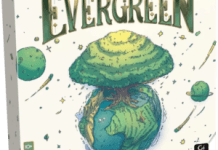

We liked
- Equipment !
- Simple but intelligent mechanics
- Smooth turns, stakeholders
We liked it less
- Pawns not easy to handle with big fingers
- It is necessary to plan from the start for the following seasons, when the sun turns
Subscribe for free to Artificielles, our newsletter on AI, designed by AIs, verified by Numerama!
Some links in this article are affiliated. We’ll explaine everything here.
